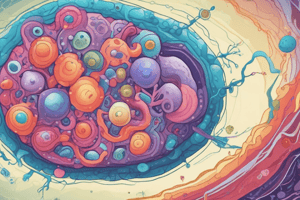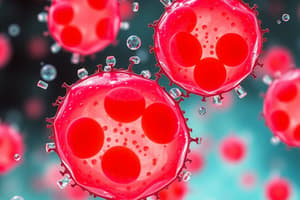Podcast
Questions and Answers
What is the basic structural, functional, and biological unit of all known living organisms?
What is the basic structural, functional, and biological unit of all known living organisms?
- Tissue
- Organ
- Cell (correct)
- Organ System
What does the term 'prokaryote' literally mean?
What does the term 'prokaryote' literally mean?
- Without a nucleus
- After having a nucleus
- Having a nucleus
- Before having a nucleus (correct)
What is a characteristic of prokaryotic cells?
What is a characteristic of prokaryotic cells?
- They are simpler and smaller than eukaryotic cells (correct)
- They undergo mitosis
- They have a large size
- They have a true nucleus
How do prokaryotic cells reproduce?
How do prokaryotic cells reproduce?
Examples of prokaryotes include:
Examples of prokaryotes include:
Flashcards are hidden until you start studying
Study Notes
Cell Characteristics
- The cell is the fundamental unit of all living organisms, serving as the basic structural, functional, and biological unit.
Cell Types
- There are two primary types of cells: prokaryotic and eukaryotic.
Prokaryotic Cells
- Lack a nucleus, and their genetic material (DNA) is found in a nuclear area within the cell.
- Are smaller and simpler in structure compared to eukaryotic cells.
- Do not possess membrane-bound cell organelles, such as a nucleus.
- Reproduce through binary fission.
- Examples include bacteria and Archaea.
Studying That Suits You
Use AI to generate personalized quizzes and flashcards to suit your learning preferences.




